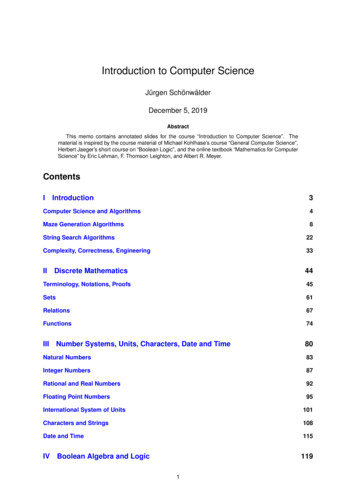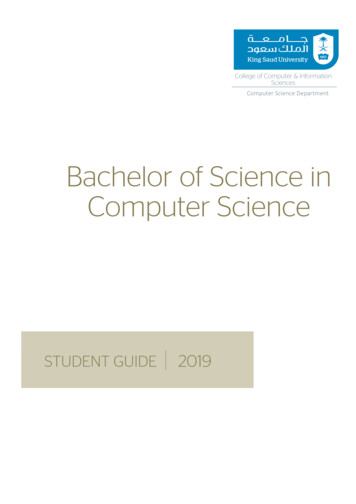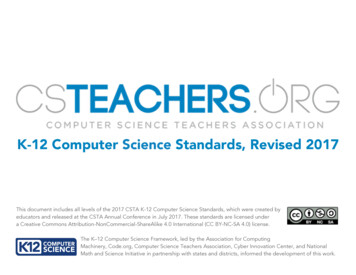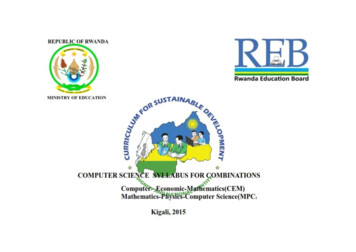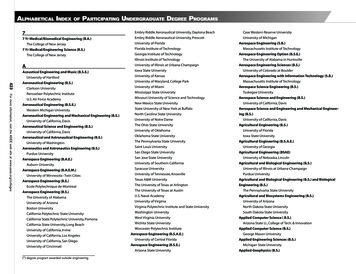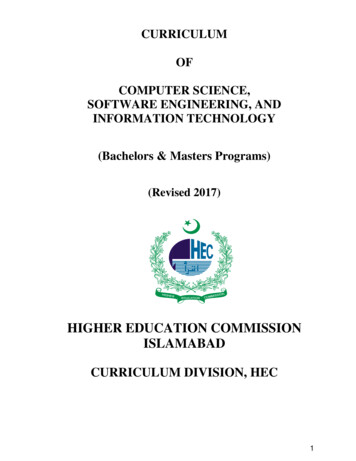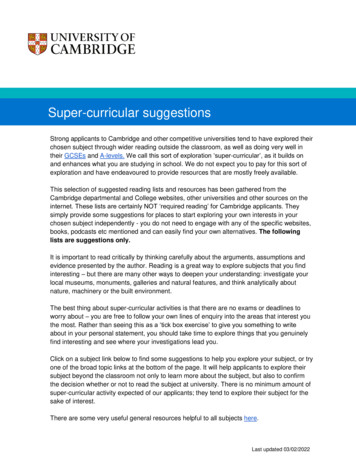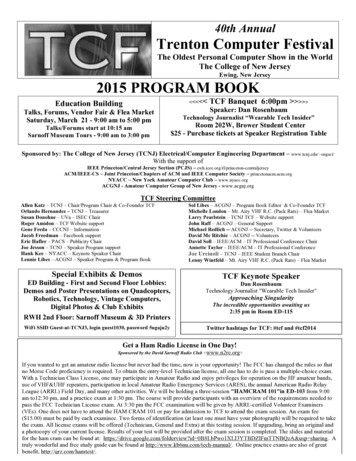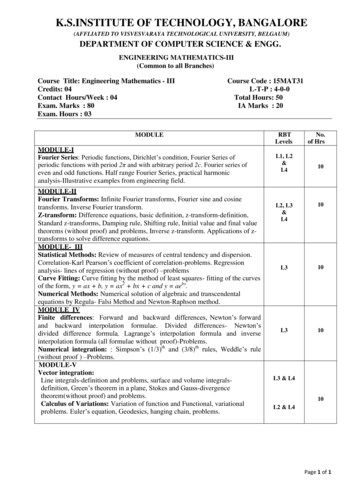
Transcription
K.S.INSTITUTE OF TECHNOLOGY, BANGALORE(AFFLIATED TO VISVESVARAYA TECHNOLOGICAL UNIVERSITY, BELGAUM)DEPARTMENT OF COMPUTER SCIENCE & ENGG.ENGINEERING MATHEMATICS-III(Common to all Branches)Course Title: Engineering Mathematics - IIICredits: 04Contact Hours/Week : 04Exam. Marks : 80Exam. Hours : 03Course Code : 15MAT31L-T-P : 4-0-0Total Hours: 50IA Marks : 20MODULEMODULE-IFourier Series: Periodic functions, Dirichlet’s condition, Fourier Series ofperiodic functions with period 2π and with arbitrary period 2c. Fourier series ofeven and odd functions. Half range Fourier Series, practical harmonicanalysis-Illustrative examples from engineering field.MODULE-IIFourier Transforms: Infinite Fourier transforms, Fourier sine and cosinetransforms. Inverse Fourier transform.Z-transform: Difference equations, basic definition, z-transform-definition,Standard z-transforms, Damping rule, Shifting rule, Initial value and final valuetheorems (without proof) and problems, Inverse z-transform. Applications of ztransforms to solve difference equations.MODULE- IIIStatistical Methods: Review of measures of central tendency and dispersion.Correlation-Karl Pearson’s coefficient of correlation-problems. Regressionanalysis- lines of regression (without proof) –problemsCurve Fitting: Curve fitting by the method of least squares- fitting of the curvesof the form, y ax b, y ax2 bx c and y aebx.Numerical Methods: Numerical solution of algebraic and transcendentalequations by Regula- Falsi Method and Newton-Raphson method.MODULE IVFinite differences: Forward and backward differences, Newton’s forwardand backward interpolation formulae. Divided differences- Newton’sdivided difference formula. Lagrange’s interpolation formula and inverseinterpolation formula (all formulae without proof)-Problems.Numerical integration: : Simpson’s (1/3)th and (3/8)th rules, Weddle’s rule(without proof ) –Problems.MODULE-VVector integration:Line integrals-definition and problems, surface and volume integralsdefinition, Green’s theorem in a plane, Stokes and Gauss-divergencetheorem(without proof) and problems.Calculus of Variations: Variation of function and Functional, variationalproblems. Euler’s equation, Geodesics, hanging chain, problems.RBTLevelsL1, L2&L4No.of Hrs10L2, L3&L410L310L310L3 & L410L2 & L4Page 1 of 1
Course Outcomes: On completion of this course, students are able to:Make use of Fourier series to analyze wave forms of periodic functionsMake use of Fourier transforms and Z - transforms to analyze wave forms of non periodic functionsIdentify statistical methods to find correlation and regression lines, also numerical methods to solvetranscendental equations.Utilize Numerical techniques for various finite difference technique problemsConstruct Greens, divergence and Stokes theorems for various engineering applications Solve theproblems on signals and systems, heat conduction, and control; engineering by using variousnumerical techniquesQuestion paper pattern:The question paper will have ten full questions carrying equal marks.Each full question consisting of 16 marks.There will be two full questions (with a maximum of four sub questions)from each module.Each full question will have sub question covering all the topics under a module.The students will have to answer five full questions, selecting one full question fromeach module.Text Books:1. B.S. Grewal: Higher Engineering Mathematics, Khanna Publishers, 43rd Ed., 2015.2. E. Kreyszig: Advanced Engineering Mathematics, John Wiley & Sons, 10th Ed., 2015.Reference books:1. N.P.Bali and Manish Goyal: A Text Book of Engineering Mathematics, Laxmi Publishers,7th Ed., 2010.B.V.Ramana: "Higher Engineering M athematics" Tata McGraw-Hill, 2006.H. K. Dass and Er. RajnishVerma: "Higher Engineerig Mathematics",S. Chandpublishing, 1st edition, 2011.We links and Video Lectures:1. http://nptel.ac.in/courses.php?disciplineID 1112. http://wwww.khanacademy.org/3. http://www.class-central.com/subject/mathPage 2 of 1
Analog and Digital Electronics[As per Choice Based Credit System (CBCS) scheme](Effective from the academic year 2015 -2016)SEMESTER - IIISubject Code15CS32IA Marks20Number of Lecture Hours/Week04Exam Marks80Total Number of Lecture Hours50Exam Hours03CREDITS – 04Module -1TeachingHoursField Effect Transistors: Junction Field Effect Transistors, MOSFETs, Differencesbetween JFETs and MOSFETs, Biasing MOSFETs, FET Applications, CMOS Devices.Wave-Shaping Circuits: Integrated Circuit(IC) Multivibrators.IntroductiontoOperational Amplifier: Ideal v/s practical Opamp, Performance Parameters, OperationalAmplifier Application Circuits:Peak Detector Circuit, Comparator, Active Filters, NonLinear Amplifier, Relaxation Oscillator, Current-To-Voltage Converter, Voltage-ToCurrent Converter.Text book 1:- Ch 5: 5.2, 5.3, 5.5, 5.8, 5.9, 5.1.Ch13: 13.10.Ch 16: 16.3, 16.4. Ch 17:7.12, 17.14, 17.15, 17.18, 17.19, 17.20, 17.21.10 HoursModule -2The Basic Gates: Review of Basic Logic gates, Positive and Negative Logic, Introductionto HDL. Combinational Logic Circuits: Sum-of-Products Method, Truth Table toKarnaugh Map, Pairs Quads, and Octets, Karnaugh Simplifications, Don’t-care Conditions,Product-of-sums Method, Product-of-sums simplifications, Simplification by QuineMcClusky Method, Hazards and Hazard covers, HDL Implementation Models.Text book 2:- Ch 2: 2.4, 2.5. Ch3: 3.2 to 3.11.10 HoursModule – 31 Page
Data-Processing Circuits: Multiplexers, Demultiplexers, 1-of-16 Decoder, BCD toDecimal Decoders, Seven Segment Decoders, Encoders, Exclusive-OR Gates, ParityGenerators and Checkers, Magnitude Comparator, Programmable Array Logic,Programmable Logic Arrays, HDL Implementation of Data Processing Circuits. ArithmeticBuilding Blocks, Arithmetic Logic Unit Flip- Flops: RS Flip-Flops, Gated Flip-Flops, Edgetriggered RS FLIP-FLOP, Edge-triggered D FLIP-FLOPs, Edge-triggered JK FLIP- FLOPs.Text book 2:- Ch 4:- 4.1 to 4.9, 4.11, 4.12, 4.14.Ch 6:-6.7, 6.10.Ch 8:- 8.1 to 8.5.10 HoursModule-4Flip- Flops: FLIP-FLOP Timing, JK Master-slave FLIP-FLOP, Switch Contact BounceCircuits, Various Representation of FLIP-FLOPs, HDL Implementation of FLIP-FLOP.Registers: Types of Registers, Serial In - Serial Out, Serial In - Parallel out, Parallel In Serial Out, Parallel In - Parallel Out, Universal Shift Register, Applications of ShiftRegisters, Register implementation in HDL. Counters: Asynchronous Counters, DecodingGates, Synchronous Counters, Changing the Counter Modulus.(Text book 2:- Ch 8: 8.6, 8.8, 8.9, 8.10, 8.13. Ch 9: 9.1 to 9.8. Ch 10: 10.1 to 10.410 HoursModule-5Counters: Decade Counters, Presettable Counters, Counter Design as a Synthesis problem,A Digital Clock, Counter Design using HDL. D/A Conversion and A/D Conversion:Variable, Resistor Networks, Binary Ladders, D/A Converters, D/A Accuracy andResolution, A/D Converter-Simultaneous Conversion, A/D Converter-Counter Method,Continuous A/D Conversion, A/D Techniques, Dual-slope A/D Conversion, A/D Accuracyand Resolution.Text book 2:- Ch 10: 10.5 to 10.9. Ch 12: 12.1 to 12.10.10 HoursCourse outcomes:After Studying this course, students will be able toUtilize the JFETs and MOSFETs , Operational Amplifier circuits for different applicationsConstruct the Combinational Logic circuits, Simplification Techniques using Karnaugh Maps, QuineMcClusky TechniqueApply the knowledge of Operation of Decoders, Encoders, Multiplexers, Adders , Subtractors forconstructing different circuitsMake use of the latches, Flip-Flops, Registers, Counters for constructing sequential circuitsIdentify the applications of Synchronous and Asynchronous counters, A/D and D/A Converters2 Page
Question paper pattern:The question paper will have ten questions.There will be 2 questions from each module.Each question will have questions covering all the topics under a module.The students will have to answer 5 full questions, selecting one full question from each module.Text Books:1. Anil K Maini, Varsha Agarwal: Electronic Devices and Circuits, Wiley, 2012.2. Donald P Leach, Albert Paul Malvino & Goutam Saha: Digital Principles and Applications, 8thEdition, Tata McGraw Hill, 2015Reference Books:1. Stephen Brown, Zvonko Vranesic: Fundamentals of Digital Logic Design with VHDL, 2nd Edition, TataMcGraw Hill, 2005.2. R D Sudhaker Samuel: Illustrative Approach to Logic Design, Sanguine-Pearson, 2010.3. M Morris Mano: Digital Logic and Computer Design, 10th Edition, Pearson, 2008.3 Page
DATA STRUCTURES AND APPLICATIONS[As per Choice Based Credit System (CBCS) scheme](Effective from the academic year 2015 -2016)Subject CodeSEMESTER - IIIIA Marks15CS3320Number of Lecture Hours/Week04Exam Marks80Total Number of Lecture Hours50Exam Hours03CREDITS - 04Module -1TeachingHoursIntroduction: Data Structures, Classifications (Primitive & Non Primitive), Data structureOperations, Review of Arrays, Structures, Self-Referential Structures, and Unions.Pointers and Dynamic Memory Allocation Functions. Representation of Linear Arrays in 10 HoursMemory, Dynamically allocated arrays, Array Operations: Traversing, inserting, deleting,searching, and sorting. Multidimensional Arrays, Polynomials and Sparse Matrices.Strings: Basic Terminology, Storing, Operations and Pattern Matching algorithms.Programming Examples.Text 1: Ch 1: 1.2, Ch 2: 2.2 -2.7Text 2: Ch 1: 1.1 -1.4, Ch 3: 3.1-3.3,3.5,3.7, Ch 4: 4.1-4.9,4.14Ref 3: Ch 1: 1.4Module -2Stacks and QueuesStacks: Definition, Stack Operations, Array Representation of Stacks, Stacks usingDynamic Arrays, Stack Applications: Polish notation, Infix to postfix conversion, 10 Hoursevaluation of postfix expression, Recursion - Factorial, GCD, Fibonacci Sequence, Towerof Hanoi, Ackerman's function. Queues: Definition, Array Representation, QueueOperations, Circular Queues, Circular queues using Dynamic arrays, Dequeues, PriorityQueues, A Mazing Problem. Multiple Stacks and Queues. Programming Examples.Text 1: Ch 3: 3.1 -3.7Text 2: Ch 6: 6.1 -6.3, 6.5, 6.7-6.10, 6.12, 6.13Module - 34 Page
Linked Lists: Definition, Representation of linked lists in Memory, Memory allocation;Garbage Collection. Linked list operations: Traversing, Searching, Insertion, and Deletion.Doubly Linked lists, Circular linked lists, and header linked lists. Linked Stacks and 10 HoursQueues. Applications of Linked lists – Polynomials, Sparse matrix representation.Programming ExamplesText 1: Ch 4: 4.1 -4.8 except 4.6Text 2: Ch 5: 5.1 – 5.10Module-4Trees: Terminology, Binary Trees, Properties of Binary trees, Array and linkedRepresentation of Binary Trees, Binary Tree Traversals - Inorder, postorder, preorder;Additional Binary tree operations. Threaded binary trees, Binary Search Trees – Definition, 10 HoursInsertion, Deletion, Traversal, Searching, Application of Trees-Evaluation of Expression,Programming ExamplesText 1: Ch 5: 5.1 –5.5, 5.7Text 2: Ch 7: 7.1 – 7.9Module-5Graphs: Definitions, Terminologies, Matrix and Adjacency List Representation OfGraphs, Elementary Graph operations, Traversal methods: Breadth First Search and Depth10 HoursFirst Search. Sorting and Searching: Insertion Sort, Radix sort, Address Calculation Sort.Hashing: Hash Table organizations, Hashing Functions, Static and Dynamic Hashing.Files and Their Organization: Data Hierarchy, File Attributes, Text Files and BinaryFiles, Basic File Operations, File Organizations and IndexingText 1: Ch 6: 6.1 –6.2, Ch 7:7.2, Ch 8:8.1-8.3Text 2: Ch 8: 8.1 – 8.7, Ch 9:9.1-9.3,9.7,9.9Reference 2: Ch 16: 16.1 - 16.7Course outcomes:After studying this course, students will be able to:Apply the fundamental concepts of data structures and their applications essential forprogramming/problem solving.Make use of linear data structures such as stacks and queues to implement their respective applicationsIdentify the different types of linked lists and their applications.Construct various types of trees to implement their applications.Develop various applications using different data structures, searching, sorting, hashing and files concepts.5 Page
Question paper pattern:The question paper will have ten questions.There will be 2 questions from each module.Each question will have questions covering all the topics under a module.The students will have to answer 5 full questions, selecting one full question from each module.Text Books:1. Fundamentals of Data Structures in C - Ellis Horowitz and Sartaj Sahni, 2nd edition, UniversitiesPress,20142. Data Structures - Seymour Lipschutz, Schaum's Outlines, Revised 1st edition, McGraw Hill, 2014Reference Books:1. Data Structures: A Pseudo-code approach with C –Gilberg & Forouzan, 2nd edition, Cengage Learning,2.3.4.5.2014.Data Structures using C, , Reema Thareja, 3rd edition Oxford press, 2012.An Introduction to Data Structures with Applications- Jean-Paul Tremblay & Paul G. Sorenson, 2ndEdition, McGraw Hill, 2013.Data Structures using C - A M Tenenbaum, PHI, 1989.Data Structures and Program Design in C - Robert Kruse, 2nd edition, PHI, 1996.6 Page
COMPUTER ORGANIZATION[As per Choice Based Credit System (CBCS) scheme](Effective from the academic year 2015 -2016)Subject CodeSEMESTER - IIIIA Marks15CS3420Number of Lecture Hours/Week04Exam Marks80Total Number of Lecture Hours50Exam Hours03CREDITS – 04Module -1TeachingHoursBasic Structure of Computers: Basic Operational Concepts, Bus Structures, Performance– Processor Clock, Basic Performance Equation, Clock Rate, Performance Measurement.Machine Instructions and Programs: Memory Location and Addresses, Memory 10HoursOperations, Instructions and Instruction Sequencing, Addressing Modes, AssemblyLanguage, Basic Input and Output Operations, Stacks and Queues, Subroutines, AdditionalInstructions, Encoding of Machine InstructionsTextbook 1: Ch 1: 1.3, 1.4, 1.6.1, 1.6.2, 1.6.4, 1.6.7. Ch 2: 2.2 to 2.10, 2.12Module -2Input/Output Organization: Accessing I/O Devices, Interrupts – Interrupt Hardware,Enabling and Disabling Interrupts, Handling Multiple Devices, Controlling Device10 HoursRequests, Exceptions, Direct Memory Access, Buses, Interface Circuits, Standard I/OInterfaces – PCI Bus, SCSI Bus, USB.Textbook 1: Ch 4: 4.1, 4.2: 4.2.1 to 4.2.5, 4.4 to 4.7.Module – 3Memory System: Basic Concepts, Semiconductor RAM Memories, Read Only Memories,Speed, Size, and Cost, Cache Memories – Mapping Functions, Replacement Algorithms,10 HoursPerformance Considerations, Virtual Memories, Secondary Storage.Textbook 1: Ch 5: 5.1 to 5.4, 5.5.1, 5.5.2, 5.6, 5.7, 5.9Module-47 Page
Arithmetic: Numbers, Arithmetic Operations and Characters, Addition and Subtraction ofSigned Numbers, Design of Fast Adders, Multiplication of Positive Numbers, Signed10 HoursOperand Multiplication, Fast Multiplication, Integer Division, Floating-point Numbers andOperations.Textbook 1: Ch 2: 2.1, Ch 6: 6.1 to 6.7Module-5Basic Processing Unit: Some Fundamental Concepts, Execution of aCompleteInstruction, Multiple Bus Organization, Hard-wired Control, Micro programmed Control.10 HoursEmbedded Systems and Large Computer Systems: Examples of Embedded Systems,Processor chips for embedded applications, Simple Microcontroller. The structure ofGeneral-Purpose Multiprocessors.Textbook 1: Ch 7: 7.1 to 7.5, Ch 9:9.1 to 9.3, Ch 12:12.3Course outcomes:After studying this course, students will be able to:Make use of basic architecture & organization of a computer system, machine instruction formats andaddressing modes.Select techniques for I/O communication with standard bus interfaces and interrupt service routines.Identify different memories and memory mapping techniques.Develop different arithmetic operational units.Utilize control sequences for hardwired and micro-program control units for both single and multi busprocessors.Question paper pattern:The question paper will have ten questions.There will be 2 questions from each module.Each question will have questions covering all the topics under a module.The students will have to answer 5 full questions, selecting one full question from each module.Text Books:1. Carl Hamacher, Zvonko Vranesic, Safwat Zaky: Computer Organization, 5th Edition, Tata McGraw Hill,2002.Reference Books:1. William Stallings: Computer Organization & Architecture, 9th Edition, Pearson, 2015.8 Page
UNIX AND SHELL PROGRAMMING[As per Choice Based Credit System (CBCS) scheme](Effective from the academic year 2015 -2016)Subject CodeSEMESTER – IIIIA Marks15CS3520Number of Lecture Hours/Week04Exam Marks80Total Number of Lecture Hours50Exam Hours03CREDITS – 04Module -1TeachingHoursIntroduction, Brief history. Unix Components/Architecture. Features of Unix. The UNIXEnvironment and UNIX Structure, Posix and Single Unix specification. The login prompt.General features of Unix commands/ command structure. Command arguments andoptions. Understanding of some basic commands such as echo, printf, ls, who, date,passwd, cal, Combining commands. Meaning of Internal and external commands. The typecommand: knowing the type of a command and locating it. The man command knowingmore about Unix commands and using Unix online manual pages. The man with keywordoption and whatis. The more command and using it with other commands. Knowing theuser terminal, displaying its characteristics and setting characteristics. Managing the nonuniform behaviour of terminals and keyboards. The root login. Becoming the super user: sucommand. The /etc/passwd and /etc/shadow files. Commands to add, modify and deleteusers.10HoursTopics from chapter 2 , 3 and 15 of text book 1,chapter 1 from text book 2Module -2Unix files. Naming files. Basic file types/categories. Organization of files. Hidden files.Standard directories. Parent child relationship. The home directory and the HOMEvariable. Reaching required files- the PATH variable, manipulating the PATH, Relativeand absolute pathnames. Directory commands – pwd, cd, mkdir, rmdir commands. The dot(.) and double dots (.) notations to represent present and parent directories and their usagein relative path names. File related commands – cat, mv, rm, cp, wc and od commands.File attributes and permissions and knowing them. The ls command with options.Changing file permissions: the relative and absolute permissions changing methods.Recursively changing file permissions. Directory permissions.10HoursTopics from chapters 4, 5 and 6 of text book 19 Page
Module – 3The vi editor. Basics. The .exrc file. Different ways of invoking and quitting vi. Differentmodes of vi. Input mode commands. Command mode commands. The ex mode commands.Illustrative examples Navigation commands. Repeat command. Pattern searching. Thesearch and replace command. The set, map and abbr commands. Simple examples usingthese commands.10HoursThe shells interpretive cycle. Wild cards and file name generation. Removing the specialmeanings of wild cards. Three standard files and redirection. Connecting commands: Pipe.Splitting the output: tee. Command substitution. Basic and Extended regular expressions.The grep, egrep. Typical examples involving different regular expressions.Topics from chapters 7, 8 and 13 of text book 1. Topics from chapter 2 and 9 ,10 oftext book 2Module-4Shell programming. Ordinary and environment variables. The .profile. Read and readonlycommands. Command line arguments. exit and exit status of a command. Logical operatorsfor conditional execution. The test command and its shortcut. The if, while, for and casecontrol statements. The set and shift commands and handling positional parameters. Thehere ( ) document and trap command. Simple shell program examples. File inodes andthe inode structure. File links – hard and soft links. Filters. Head and tail commands. Cutand paste commands. The sort command and its usage with different options. The umaskand default file permissions. Two special files /dev/null and /dev/tty.10HoursTopics from chapter 11, 12, 14 of text book 1,chapter 17 from text book2Module-5Meaning of a process. Mechanism of process creation. Parent and child process. The pscommand with its options. Executing a command at a specified point of time: at command.Executing a command periodically: cron command and the crontab file. Signals. The niceand nohup commands. Background processes. The bg and fg command. The kill command.The find command with illustrative example.Structure of a perl script. Running a perl script. Variables and operators. String handlingfunctions. Default variables - and . – representing the current line and current linenumber. The range operator. Chop() and chomp() functions. Lists and arrays. The @variable. The splice operator, push(), pop(), split() and join(). File handles and handling file– using open(), close() and die () functions. Associative arrays – keys and value functions.Overview of decision making loop control structures – the foreach. Regular expressions –simple and multiple search patterns. The match and substitute operators. Defining andusing subroutines.Topics from chapter 9 and 19 of text book 1. Topics from chapter 11 of referencebook 110Hours10 P a g e
Course outcomes:After studying this course, students will be able to:Identify the components of UNIX Architecture, vi editor, internal and external commands.Make use of UNIX operating system file and directory commands to change attributes, permissions.Experiment with commands of vi editor and regular expression for pattern matching.Develop shell scripts using UNIX constructs to achieve tasks.Build parent and child processes and Perl scripts using functions, list and arrays.Question paper pattern:The question paper will have ten questions.There will be 2 questions from each module.Each question will have questions covering all the topics under a module.The students will have to answer 5 full questions, selecting one full question from each module.Text Books:1. Sumitabha Das., Unix Concepts and Applications., 4th Edition., Tata McGraw Hill2. Behrouz A. Forouzan, Richard F. Gilberg : UNIX and Shell Programming- Cengage Learning – IndiaEdition. 2009.Reference Books:1. M.G. Venkatesh Murthy: UNIX & Shell Programming, Pearson Education.2. Richard Blum , Christine Bresnahan : Linux Command Line and Shell Scripting Bible, 2ndEdition ,Wiley,2014.11 P a g e
DISCRETE MATHEMATICAL STRUCTURES[As per Choice Based Credit System (CBCS) scheme](Effective from the academic year 2015 -2016)Subject CodeSEMESTER – IIIIA Marks15CS3620Number of Lecture Hours/Week04Exam Marks80Total Number of Lecture Hours50Exam Hours03CREDITS – 04Module -1TeachingHoursFundamentals of Logic: Basic Connectives and Truth Tables, Logic Equivalence – TheLaws of Logic, Logical Implication – Rules of Inference. The Use of Quantifiers,Quantifiers, Definitions and the Proofs of Theorems,Textbook 1: Ch 210HoursModule -2Properties of the Integers: Mathematical Induction, The Well Ordering Principle – 10 HoursMathematical Induction, Recursive Definitions. Fundamental Principles of Counting:The Rules of Sum and Product, Permutations, Combinations – The Binomial Theorem,Combinations with Repetition,Textbook 1: Ch 4: 4.1, 4.2 Ch 1.Module – 3Relations and Functions: Cartesian Products and Relations, Functions – Plain and One-toOne, Onto Functions. The Pigeon-hole Principle, Function Composition and InverseFunctions. Properties of Relations, Computer Recognition – Zero-One Matrices andDirected Graphs, Partial Orders – Hasse Diagrams, Equivalence Relations and Partitions.Textbook 1: Ch 5:5.1 to 5.3, 5.5, 5.6, Ch 7:7.1 to 7.410 HoursModule-412 P a g e
The Principle of Inclusion and Exclusion: The Principle of Inclusion and Exclusion, 10 HoursGeneralizations of the Principle, Derangements – Nothing is in its Right Place, RookPolynomials. Recurrence Relations: First Order Linear Recurrence Relation, The SecondOrder Linear Homogeneous Recurrence Relation with Constant Coefficients.Textbook 1: Ch 8: 8.1 to 8.4, Ch 10:10.1 to 10.2Module-5Introduction to Graph Theory: Definitions and Examples, Sub graphs, Complements,and Graph Isomorphism, Vertex Degree, Euler Trails and Circuits , Trees: Definitions,Properties, and Examples, Routed Trees, Trees and Sorting, Weighted Trees and PrefixCodes10HoursTextbook 1: Ch 11: 11.1 to 11.3, Ch 12: 12.1 to 12.4Course outcomes:After studying this course, students will be able to:Interpret propositional and predicate logic in knowledge representation and truth verification.Demonstrate the properties of integers and fundamental principle of counting in discrete structures.Utilize the understandings of relations and functions and be able to determine their propertiesSolve the problems using the concept of graph theory and trees propertiesSolve problems using recurrence relations and Principle of Inclusion and ExclusionQuestion paper pattern:The question paper will have ten questions.There will be 2 questions from each module.Each question will have questions covering all the topics under a module.The students will have to answer 5 full questions, selecting one full question from each module.Text Books:1. Ralph P. Grimaldi: Discrete and Combinatorial Mathematics, , 5th Edition, Pearson Education. 2004.Reference Books:1. Basavaraj S Anami and Venakanna S Madalli: Discrete Mathematics – A Concept based approach,2.3.4.5.Universities Press, 2016Kenneth H. Rosen: Discrete Mathematics and its Applications, 6th Edition, McGraw Hill, 2007.Jayant Ganguly: A Treatise on Discrete Mathematical Structures, Sanguine-Pearson, 2010.D.S. Malik and M.K. Sen: Discrete Mathematical Structures: Theory and Applications, Thomson,2004.Thomas Koshy: Discrete Mathematics with Applications, Elsevier, 2005, Reprint 2008.13 P a g e
ANALOG AND DIGITAL ELECTRONICS LABORATORY[As per Choice Based Credit System (CBCS) scheme](Effective from the academic year 2015 -2016)SEMESTER - IIILaboratory CodeIA Marks2015CSL37Number of Lecture Hours/Week01I 02PExam Marks80Total Number of Lecture Hours40Exam Hours03CREDITS – 02Descriptions (if any)Any simulation package like MultiSim / P-spice /Equivalent software may be used.Faculty-in-charge should demonstrate and explain the required hardware components and theirfunctional Block diagrams, timing diagrams etc. Students have to prepare a write-up on the sameand include it in the Lab record and to be evaluated.Laboratory Session-1: Write-upon analog components; functional block diagram, Pin diagram (ifany), waveforms and description. The same information is also taught in theory class; this helpsthe students to understand better.Laboratory Session-2: Write-upon Logic design components, pin diagram (if any), Timingdiagrams, etc. The same information is also taught in theory class; this helps the students tounderstand better.Note: These TWO Laboratory sessions are used to fill the gap between theory classes andpractical sessions. Both sessions are to be evaluated for 20 marks as lab experiments.14 P a g e
Laboratory Experiments:1. a) Design and construct a Schmitt trigger using Op-Amp for given UTP and LTPvalues and demonstrate its working.b) Design and implement a Schmitt trigger using Op-Amp using a simulationpackage for two sets of UTP and LTP values and demonstrate its working.2. a) Design and construct a rectangular waveform generator (Op-Amp relaxationoscillator) for given frequency and demonstrate its working.b) Design and implement a rectangular waveform generator (Op-Amp relaxationoscillator) using a simulation package and demonstrate the change infrequency when all resistor values are doubled.3. Design and implement an Astable multivibrator circuit using 555 timer for agiven frequency and duty cycle.NOTE: hardware and software results need to be comparedContinued:4. Design and implement Half adder, Full Adder, Half Subtractor, Full Subtractorusing basic gates.5. a) Given a 4-variable logic expression, simplify it using Entered Variable Mapand realize the simplified logic expression using 8:1 multiplexer IC.b) Design and develop the Verilog /VHDL code for an 8:1 multiplexer. Simulateand verify its working.6.a) Design and implement codeto Binary Code using basic gates.converterI)Binary to Gray (II) Gray7. Design and verify the Truth Table of 3-bit Parity Generator and 4-bit ParityChecker using basic Logic Gates with an even parity bit.8. a) Realize a J-K Master / Slave Flip-Flop using NAND gates and verify its truthtable.b) Design and develop the Verilog / VHDL code for D Flip-Flop with positiveedge triggering. Simulate and verify its working.9. a) Design and implement a mod-n (n 8) synchronous up counter using J-K FlipFlop ICs and demonstrate its working.b) Design and develop the Verilog / VHDL code for mod-8 up counter. Simulateand verify its working.10. Design and implement an asynchronous counter using decade counter IC tocount up from 0 to n (n 9) and demonstrate on 7-segment display (using IC7447).11. Generate a Ramp output waveform using DAC0800 (Inputs are given to DACthrough IC74393 dual 4-bit binary counter).15 P a g e
Study experiment12. To study 4-bitALU using IC-74181.Course outcomes:On the completion of this laboratory course, the students will be able to:. Utilize Operational Amplifier and timers for different applications also make use ofsimulation package to design circuitsChoose the Combinational Logic circuits for realizing adders, subtractors and multiplexers,Construct code converters, parity generation and checking circuitsDesign MSJK Flip Flop, synchronous and asynchronous counters also make use ofsimulation package to design circuitsMake use of DAC 0800 to generate ramp waveformConduction of Practical Examination:1 . All laboratory experiments (1 to 11 nos) are to be included for practical examination.2 . Students are allowed to pick one experiment from the lot.3 . Strictly follow the instructions as printed on the cover page of answer script.4 . Marks distribution:a ) For questions having part a only- Procedure Conduction Viva:20 50 10 80 Marksb ) For questions having part a and bPart a- Procedure Conduction Viva:10 35 05 50 MarksPart b- Procedu
analysis-Illustrative examples from engineering field. L1, L2 & L4 10 MODULE-II Fourier Transforms: Infinite Fourier transforms, Fourier sine and cosine transforms. Inverse Fourier transform. Z-transform: Difference equations, basic definition, z-transform-definition, Standard z-transforms, Damping rule, Shifting rule, Initial value and final value


